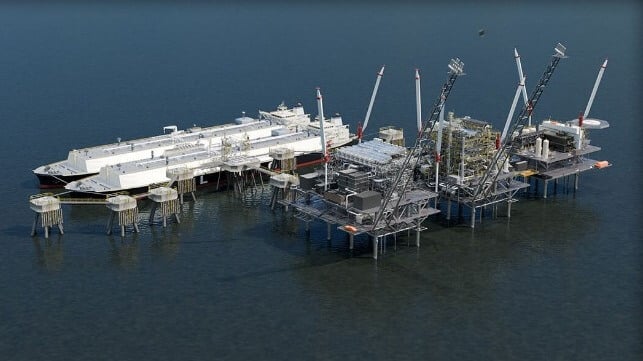MARAD Receives Proposal for Floating Offshore LNG Export Terminal off Texas

With the rush to expand the U.S. LNG export business and strong support from the Trump administration for the energy sector, a developer has filed a novel proposal with the Maritime Administration (MARAD) and the U.S. Coast Guard. In a notice to be published on Monday, July 7, in the Federal Register, MARAD and USCG report that the application is sufficiently complete to start processing the proposal from the company called ST LNG for the ST LNG Deepwater Port Development Project.
The application was filed on June 9 and seeks to take advantage of the U.S.’s Deepwater Port Act of 1974. The act provides for a public hearing to be conducted within 240 days after publication of the notice and a decision on the application not later than 90 days after the final public hearing.
The new company is being led by an entrepreneur and businessman, Sharad Tak, who has built a range of successful companies and is CEO of ST LNG. Bringing experience in the energy sector is Alap Shah, who is president of ST LNG and previously was Managing Director of FLNG Development at New Fortress Energy. ST reports that Alap conceptualized and executed the FAST LNG program involving multiple liquefaction trains on various marine infrastructures from 2021-2024. Before this project, he was involved in the Golar Hilli and Golar Gimi FLNG projects through Black & Veatch.
The new terminal would be located approximately 10.4 nautical miles offshore Matagorda, Texas. When fully realized, the application reports that the project would involve four 2.1 million tonnes per annum (MTPA) liquefaction systems installed in the Brazos Outer Continental Shelf Lease Block 476, in approximately 65 to 72 feet of water. The proposed ST LNG deepwater port would export LNG up to 8.4 MTPA. The LNG would be loaded onto standard LNG carriers with cargo capacities between 125,000 and 180,000 cubic meters.
The proposed ST LNG deepwater port would consist of fixed and floating components. These components would include a 5.5-mile, 30-inch pipeline lateral with a connection hub, four feeder lines to the connection hub, four gas treatment platforms, four liquefaction platforms, four accommodation and utility platforms, four LNG transfer platforms, thirty-six mooring dolphins, four converted LNG carriers, and three tugs.
The project would be completed in four phases. Phase 1 construction would include three large platforms (a gas treatment platform, an LNG liquefaction platform, and an accommodations and utility platform), one LNG transfer platform, nine mooring dolphins, one floating storage unit (FSU), and interconnected lateral pipelines. Each phase would produce 2.1 MTPA of LNG.
The company highlights that the project would largely be built in the United States, creating good-paying jobs, and once in service, would offer a cost-competitive approach.
While this proposal uses the floating approach, other companies are also seeking to leverage the Trump administration's support. Applications and proposals are appearing for new and expanded LNG terminals along the Gulf Coast as demand for LNG energy is expected to grow rapidly over the remainder of this decade.
